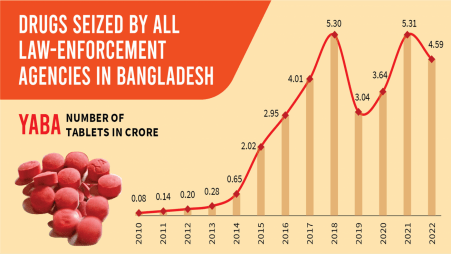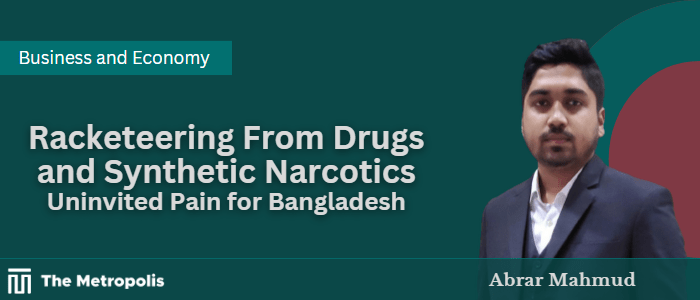Abrar Mahmud –
Every time we hear the term “money laundering,” an image of shrewd bankers or fake financial corporations comes to our mind thinking that they move money around the world. The “art” of money laundering has gained so much attention that authorities and law enforcement organizations now focus 99 percent of their attention on the banking industry alone, leaving other sectors to languish. A medicine that your mum took today could be used to launder money. “How?” can be a valid question. Readers may rest assured that the article won’t discuss the procedure in the same ridiculous way that the Netflix series “Ozark” did before they guess the answer.
According to a UNCTAD report published on 8th June 2023, estimated that between 2017 and 2021, drug trafficking is anticipated to have produced $481 million in IFFs (outward illicit financial flows) in Bangladesh. This projection takes heroin, methamphetamine pills, and synthetic opioids like buprenorphine and Phensidyl into account. The drug trafficking problem is so acute that Bangladesh ranks 5th in the world in terms of drug money laundering. And Bangladesh is at the top in Asia. In 2018, the Bangladesh government declared ‘zero tolerance’ on drug trafficking but still in 2023 we couldn’t improve much from the report of UNCTAD. To eradicate the problem, we have to know the procedure for laundering money by using the drug market. The basic stages of drug trafficking money laundering are:
Stage-1: Organized criminal groups earn from the local sale of opioids like fentanyl or tramadol, which is where the majority of the money made from synthetic opioid trafficking accumulates. The proceeds and the commodities may become uncoupled as the money moves toward these criminal organizations, which are in charge of the larger-scale shipments, and the proceeds may then pass through increasingly intricate money-laundering techniques.
Stage-2: The main costs for organized crime groups are the smuggling and purchase of opioids or their precursors, as well as the synthesis of synthetic opioids themselves (if clandestine manufacture is involved), which includes the purchase of manufacturing tools and equipment as well as specialized labor capable of performing the synthesis, such as chemists. Through intermediary nations and businesses, precursor products may be smuggled in this process. The delivery of precursors and the opioids themselves may be guaranteed by criminal organizations using bribery.
Stage-3: The placement stage of money laundering frequently takes place in the nation of the customer. Layering and integration most likely take place through either correspondent banking relationships (including for trade-related financial transfers), front firms, money value transfer services (including hawala), trade-based money laundering, or bulk cash smuggling. The variety of layering and integration techniques shows that there isn’t just one “business model” for criminal organizations, but rather a variety of money-laundering tactics. The criminal organizations that carry out the primary offense may receive the monetary proceeds in some mirror transfer schemes. The company then hires a seasoned money laundering business to clean up the cash gains. It sells the money launderer corporation large amounts of cash (such as dollars). The money-laundering business then arranges for the transfer of an equivalent sum of money to someone qualified to accept the payments on behalf of the original criminal organization from a different source (typically in another nation). Proceeds may be able to enter the financial system through this procedure in a way that is perhaps not suspicious.
So, every drug trafficking money launderer in the world exploits these three stages to commit financial crimes through the pharmaceutical industry. Like every other industry, drug trafficking money launderers also use an active supply chain to move illicit medicines for easy transport. Since drugs like tramadol, blood pressure pills, fentanyl, betacor, etc. are widely available in the licit pharmaceutical sector, it is challenging to trace them when they are transferred through the illicit supply chain and mixed in with legal commercial activities. Criminal organizations have been expanding their operations into new countries, contributing to the illicit drug crisis there and in other countries, weakening public health resources and the integrity of the global financial system. In this way, money launderers supply duplicate pills in the disguise of regular pills by using duplicate inventory.
Now, we will see a casework made by the Financial Transactions and Reports Analysis Centre of Canada (FINTRAC) to understand the procurement of synthetic opioids via payment using money service businesses:
-
Client makes several short-term purchases of wire transfers or money orders for sums under the CAD 10,000 reporting threshold, typically using cash or prepaid credit cards. The wire transfers and money orders are typically routed to the same recipients in Asia, Europe, and America by several, seemingly unrelated people in the Middle East.
-
Client pays for wire transfers in dollar or euro funds, which are then received in even dollar amounts.
-
Client sometimes uses a post office box as a mailing address.
-
Client receives multiple direct deposits from global payment processing and/or virtual currency exchange platforms, typically in amounts below the reporting threshold.
-
Clients ask for wire transfers to be sent to businesses that promote the sale of drugs such as opioids, fentanyl, ketamine, etc, and/or its recognized chemical precursors, including NPP (1-phenyl-4-piperidone), ANPP (4-azido-2-nitrophenyl phosphate), and Norfentanyl (N-phenyl-N-pieridin4ylpropanamide).
If we understand this case of FINTRAC, we will understand the procurement of illicit drugs by using our daily payment services.
Since Bangladesh is the hub of three major drug trafficking zones, thus numerous international drug gangs are operating there, particularly those from Nigeria and Sri Lanka. To transport drugs to other nations, they utilize Bangladesh as a transit point. Because Bangladesh’s inhabitants rely heavily on its neighbor(India) for high-quality medical care, drug dealers have been watching the country. Indeed, public health has significantly improved in Bangladesh during the past 20 to 30 years, but the country’s residents have struggled with several major illnesses and the high cost of medical care. Thus, drug traffickers use this characteristic of Bangladesh to conduct illegal financial flows through this sector. The most popular illegal drug in Bangladesh is Yaba. Other popular drugs are Phensedyl, a synthetic opioid, sleeping pills (seduxen), butanone, rectified spirit, denatured spirit, tardi, pathedine, buprenorphine (T.D. Jesic Injection), bhang, codeine tablets, fermented wASH (jawa), buprenorphine (bonozesic injection), morphine, itch pills, viagra, sanagra, toluene, potassium permanganate, and methyl-ethyl ketone.
Dedicated law enforcement agencies are operating ‘zero-tolerance’ operations on the drug dealers of Bangladesh but the illicit financial flow is on the rise for Bangladesh which is Tk 5,147 crore from 2017-21.

Addressing this situation, the Financial Action Task Force of G7 has provided some guidelines to combat drug trafficking and money laundering which Bangladesh should follow:
(i) While taking into account new advances in drug trafficking, nations should continue to detect and evaluate money laundering threats related to drug trafficking (in general). Any new trends should be included in this. About financial transactions for the acquisition of synthetic opioid precursor chemicals, their sale, and the laundering of profits through the use of internet platforms (including dark web marketplaces). Identification of instances of sales of known opioid precursors is part of the risk-based assessment and analysis process. The creation of risk indicators should benefit from such identification.
(ii) To ensure that the scope of training and awareness includes businesses (such as pharmaceutical and chemical importers) that intentionally or unintentionally provide raw materials to organizations, prosecutors, and law enforcement officials, including those with extensive backgrounds in financial investigations (which could include FIUs, customs, and relevant AML/CFT authorities), should receive additional training on investigations into the financing of the precursor supply chain.
(iii) Countries should identify and use existing channels to increase global cooperation in the fight against synthetic opioid supply chains on a bilateral, regional, and multilateral level. To promote cooperation between source, transit, and destination nations for precursors of synthetic drugs, professional money laundering networks, and the finished products, these methods may include discussions or public-private partnerships.
(iv)The risk of new technologies (such as dark web marketplaces and digital assets) to facilitate money laundering associated with drug trafficking should be made clear to private sector reporting entities so that they can take the necessary precautions to prevent criminals from accessing their business platforms or goods.
It is evident that money laundering through drug trafficking has been a global pain but it is never too late for us to coordinate as a society to uproot this problem and ensure a ‘drug trafficking-free Bangladesh ‘.
Abrar Mahmud is an undergraduate BBA (Major in Finance) student at the Army Institute of Business Administration, Savar.



